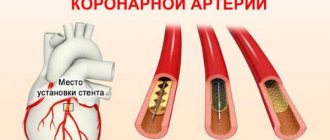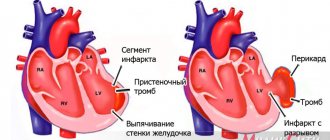General information about myocardial infarction
Myocardial infarction
ー this is the death of a section of the heart muscle, which occurs due to a lack of blood supply. As a rule, a heart attack does not develop suddenly; it is preceded by coronary heart disease or other pathology of the organ that leads to disruption of blood flow to the myocardium. Under conditions of oxygen and energy starvation, cells die. At the initial stage, this process is reversible; if blood flow is restored, the area of death can be limited and severe heart failure can be prevented.
Classification of myocardial infarction
Depending on which part of the heart wall is damaged, the following types of heart attacks are distinguished:
- intramural ー the dying zone is located deep in the myocardium;
- transmural - affects the entire thickness of the wall;
- subendocardial - the lesion is located near the inner lining of the heart;
- subepicardial - near the outer sac of the heart.
According to the nature of the flow, they are distinguished:
- acute infarction (primary);
- recurrent, develops within 2 months after acute;
- repeated, develops later than 2 months after the first heart attack.
According to the nature of the symptoms:
- typical form, characterized by chest pain radiating to the left arm and left half of the body;
- atypical forms (abdominal ー abdominal pain, asthmatic ー accompanied by severe shortness of breath, cerebral ー with dizziness, confusion, edematous, peripheral ー pain in the arm, face, neck, painless, combined).
How to give first aid
Before the medical team arrives, it is necessary to alleviate the victim’s situation:
- the elderly person is placed on the bed, given a semi-recumbent position, placing a pillow under his back;
- limit the patient’s physical activity;
- ensure complete silence and remove other people from the room;
- to ensure the flow of oxygen, open a window in the room, unbutton the patient’s clothes;
- give an elderly person a nitroglycerin tablet under the tongue for resorption, you can first bite it into pieces;
- crushed aspirin is additionally served.
It is recommended to repeat taking nitroglycerin after 7 minutes if heart pain persists and the medical team has not arrived. The patient receives the third nitroglycerin tablet 10 minutes after taking the second dosage if the pain syndrome remains intact.
In case of sweating, shortness of breath, or headache, the elderly person is given a glass of water and lies down with his legs elevated using a bolster. Under no circumstances should the patient be left alone. The victim should not be nervous.
Are there differences between heart attacks in men and women?
In women, the heart is smaller, contracts frequently, contains more fat in its tissues, and this differs from the male heart. This structure makes the symptoms of a heart attack less pronounced in the fairer sex.
Until the age of 50, women do not suffer from heart attacks because the body produces sufficient amounts of the sex hormone estrogen. The hormone, in turn, helps maintain good cholesterol and protect coronary vessels from damage. Women's hearts quickly adapt to environmental changes and are stress-resistant.
The situation changes with the onset of menopause. Estrogen production stops and the body's reserve functions weaken. About 40% of women aged 50 years and older die from a primary heart attack.
When a heart attack occurs in women, blockage of the coronary artery most often occurs; in men, blockage of the main arteries occurs. In men, acute pain behind the sternum radiates to the neck, upper and lower limbs.
In women, heart attacks often occur asymptomatically or with pain in the abdomen, back and jaw. Accompanied by loss of appetite, nausea, weakness, heartburn. Such symptoms often lead to an incorrect assessment of the condition.
Mechanism of development and causes of myocardial infarction
The lion's share of heart attacks develops against the background of atherosclerotic damage to the coronary vessels and aorta (formation of cholesterol plaques in the wall of blood vessels). Other possible causes of circulatory disorders in the heart muscle are vasospasm and thrombosis. All this leads to the fact that the cells do not receive the required amount of oxygen and die.
The main causes of myocardial infarction:
- coronary heart disease, atherosclerosis;
- sudden physical activity or stress during ischemic heart disease;
- thrombosis of the coronary arteries.
Heart attack and other age groups
In recent years, the number of young people suffering from heart attacks has tripled in Russia. In children 10-16 years old, doctors diagnose fibrous cholesterol plaques - indirect signs of a heart attack. The disease is becoming a threat not only to older people.
The modern rhythm of life in big cities is invariably associated with unhealthy eating on the go, a sedentary lifestyle, stress at work, and prolonged depression. People do not pay enough attention to their health, rarely spend time in the fresh air, and do not get enough sleep. All this negatively affects the condition of blood vessels and the functioning of the heart.
It is necessary to check your health regularly. Diseases may remain dormant for a long time and not cause trouble, but this does not mean that they do not exist. The employer obliges its employees to undergo a medical examination annually and this should not be taken lightly. Often with such examinations it is possible to identify and eliminate pathology in time.
To avoid problems, you should use the universal recipe for health - engage in accessible sports, review your diet, give up tobacco and alcohol, and learn to control your emotions!
Myocardial infarction in children
It is believed that this pathology only affects older people, but this is not so. A heart attack can also occur in a child in the following cases:
- inflammation of the coronary arteries in infectious diseases, rheumatoid arthritis, lupus and other autoimmune pathologies;
- infectious and rheumatic endocarditis (after a sore throat, for example);
- abnormalities in the structure of heart vessels;
- heart injuries;
- pheochromocytoma - a tumor that constantly produces adrenaline;
- congenital heart defects;
- heart tumors.
Risk factors for myocardial infarction
The following factors lead to the development of atherosclerosis, ischemic heart disease and, as a consequence, heart attack:
- high blood cholesterol (due to poor diet or metabolic diseases);
- obesity;
- hypertonic disease;
- smoking;
- sedentary lifestyle;
- diabetes.
Symptoms of myocardial infarction
Myocardial cells do not die immediately, since hypoxia develops gradually; they “suffer” for 1-2 hours before final death. At this time, they can still be saved, so timely seeking help determines the further outcome.
Pre-infarction state
Warning signs of a heart attack may appear several hours or even days before the attack. By seeking medical help during this period, you can prevent a disaster.
Possible signs of an impending heart attack:
- the appearance of chest pain during physical activity, emotional stress;
- sensations of interruptions in heart function, dizziness, increased heart rate;
- increased frequency of angina attacks;
- Chest pain is not relieved by nitroglycerin tablets.
Important!
Among all registered myocardial infarctions, about 20% are fatal within the first hour of the attack. It is not the doctors or “neglected medicine” that are to blame for this; death occurs even before seeking help due to the fact that the patient himself and those around him cannot recognize the attack and hesitate to call an ambulance. Therefore, if your loved ones have an increased risk of developing a heart attack, study the symptoms and algorithm of actions in case of a heart attack.
Symptoms of acute myocardial infarction
Myocardial infarction is manifested by pain. The pain is localized in the chest, radiating to the left arm, shoulder, half of the face, and side. The nature of the pain is pressing, burning. During an attack, a person feels a lack of air, fear of death, cold sticky sweat appears, and the skin turns pale.
A distinctive feature of a heart attack from angina pectoris: with the first, the pain does not subside at rest or after taking nitroglycerin, lasting more than 20 minutes.
Signs of stroke and heart attack
If you suspect a myocardial infarction or stroke, call an ambulance immediately!
Signs of a possible stroke
- Sudden numbness or weakness in the muscles of the face, arm, or leg, especially on one side of the body
- A sudden, severe and unexplained headache develops.
- Suddenly, speech difficulties arise or the person has difficulty understanding what is being said to him.
- Suddenly vision deteriorates.
- Sudden choking occurs when eating or drinking food
- Against the background of good health, dizziness, imbalance, and unsteadiness of gait suddenly appear.
Signs of a possible myocardial infarction
- Suddenly, severe (often very severe!) pain occurs in the chest (behind the breastbone). This pain can radiate to the left arm, under the left shoulder blade, sometimes even to the chin area, neck.
- The pain lasts longer than 20 minutes.
- The pain may be accompanied by cold sweat, palpitations, and fear of death.
- Nitroglycerin and other nitrates do not help with this pain.
Signs of a pre-infarction condition (unstable angina)
Unstable angina is a condition in which the possibility of developing a myocardial infarction in the near future is very high, which is why unstable angina can be considered a pre-infarction condition. Remember that the manifestations of unstable angina may seem quite harmless to you until the actual myocardial infarction develops! Be alert to changes in how you feel, especially those listed below.
- You first noticed that with little physical activity, attacks of squeezing pain or a feeling of heaviness in the chest (behind the sternum) began to appear; the pain disappeared after you stopped exercising. You have begun to tolerate physical activity much worse.
- You were previously diagnosed with normal stable angina, but in recent days, attacks of chest pain have begun to occur more often and with less physical activity.
- You first discovered that you had an attack of angina without physical activity, including at night when you were lying in bed.
- You began to take more nitroglycerin, the effect of the drugs decreased.
All these signs are very alarming - a myocardial infarction is possible in the next few hours! You need urgent hospitalization. The hospital will immediately begin treatment aimed at preventing a heart attack.
If you have symptoms of angina pectoris, and you are at the dacha, on the road, far from the city, take nitroglycerin and chew a tablet of acetylsalicylic acid (for example, Aspirin), go to bed. Next, try to call someone for help and call an ambulance.
Do not try to walk to the nearest town or station, especially if the pain in the chest resumes when moving!
Attention! Angina pectoris does not always manifest itself as pain!
A feeling of heaviness or a pressing sensation behind the sternum (“a stone has been placed”, “difficulty breathing”), which goes away on its own or a few minutes after taking nitroglycerin, are also signs of angina pectoris. Take care of your health!
Diagnosis of myocardial infarction
After hospitalization, the patient undergoes the following diagnostic measures:
- ECG;
- clinical and biochemical blood test;
- blood test for creatine phosphokinase (CPK), lactate dehydrogenase (LDH), troponin;
- EchoCG (ultrasound of the heart);
- coronary angiography.
These methods help confirm the diagnosis of a heart attack, clarify the location of the necrosis focus, and determine treatment tactics.
Forecast and prevention of heart attack
The greatest mortality from myocardial infarction is observed in the first day; therefore, if medical care was provided in a timely manner, the chances of recovery increase significantly. The overall prognosis depends on the area of damage to the heart muscle.
For prevention, you must follow these principles:
- quitting smoking and alcohol;
- proper, balanced nutrition;
- regular physical activity (check with your doctor);
- regular preventive visits to a cardiologist in the presence of diseases of the cardiovascular system.
Prevention and rehabilitation
The duration of the rehabilitation period after suffering an attack depends on the person’s age, concomitant pathologies, and the severity of the heart attack. The recovery course can be carried out at home, but it is better to use the services of rehabilitation centers that specialize in helping retirees with cardiovascular diseases.
The rehabilitation program for patients after a stroke consists of:
- from drug therapy that supports the functioning of the heart muscle;
- physical therapy, which increases the endurance of an elderly person;
- physiotherapy with hydrotherapy to train the heart and reduce pain;
- massage of individual areas of the body to improve nutrition of the heart and stimulate blood circulation.
In boarding houses, the condition of patients is monitored by medical workers. The therapeutic load is increased gradually, regularly measuring vital signs, studying ECG data and ultrasound of the heart.
Reliable means of preventing a recurrent heart attack will be:
- rejection of bad habits;
- excess weight loss;
- moderate physical activity;
- frequent exposure to fresh air;
It is important for relatives to create a calm, friendly atmosphere at home so that the pensioner does not experience anxiety and stress.
Diagnosis and treatment of myocardial infarction and pre-infarction condition in Medical
When should you see a doctor?
A person needs to consult a cardiologist if symptoms of a cardiovascular system pathology appear (chest pain, dizziness, cough, shortness of breath, bluish skin, etc.). You should not self-medicate. Numerous methods of traditional medicine are permissible for use only after the doctor’s permission and after treatment of the acute period of the disease.
Drug treatment of myocardial infarction and pre-infarction condition
Patients in a pre-infarction state are prescribed drugs that improve blood supply to the heart muscle, anti-atherosclerotic agents, and vitamin-mineral complexes.
In the acute period of a heart attack, analgesics, anticoagulants (prevent blood clotting) and thrombolytics (dissolve an already formed blood clot) are indicated.
Surgery
It is possible to more effectively restore blood supply to the myocardium through surgical intervention, which must be carried out in the first hours of a heart attack, then the chances of successful healing are greatest.
Coronary artery bypass grafting
The method of operation is to create a bypass route for blood supply to the affected area of the myocardium. The aorta and coronary vessel beyond the blockage are connected using a section of vein taken from the patient's lower leg.
Coronary artery angioplasty
Narrowing of the artery can be relieved by inserting an instrument that widens the artery through the femoral vein. Next, a stent is installed, which fixes the shape of the vessel, preventing its narrowing and restoring blood flow.
Pre-infarction condition: how to distinguish danger
The cessation of replenishment of the coronary artery, the death of a separate section of the heart muscle is a pre-infarction condition. It is characterized by narrowing of the arteries, the development of thrombosis, and blockage of blood vessels. At the time of the attack, there is acute pain in the heart area, which is almost impossible to eliminate with nitroglycerin.
Risk factors
The risk group includes patients suffering from heart failure, hypertension, and diabetes. A pre-infarction condition can be provoked by:
- hypertensive crisis;
- hypothermia of the body;
- alcohol overdose;
- heatstroke;
- excessive medication use;
- stress;
- emotional, physical stress;
- ARVI, influenza;
- arterial hypertension;
- spontaneous lifting of weights.
Due to stress and constant nervousness, a pre-infarction state is more often observed in women who are extremely impressionable and suspicious.
8
24/7
What happens?
A pre-infarction condition is considered an emergency condition requiring medical attention. The main thing is to recognize, respond in time, take urgent measures to stop an impending heart attack, call an ambulance or contact medical staff.
Myocardial infarction – unstable angina. Depending on the situation, the type is:
- initial, occurring for the first time;
- progressive (secondary): longer lasting, painful in contrast to primary, with pain radiating beyond the heart muscle;
- angina at rest, which occurs after heavy lifting or heavy physical activity;
- post-infarction angina develops against the background of a previous myocardial infarction with a time interval of 1-1.5 months;
- post-bypass: postoperative pathology manifests itself due to narrowing of the lumen of a large artery, secondary formation of atherosclerotic plaques.
Failure to take timely measures to relieve a pre-infarction condition can result in serious consequences and death.
Causes
Myocardial infarction is a consequence of thrombosis or spasm of the coronary vessels. It is provoked by a sharp release of adrenaline. A common cause of myocardial infarction is arterial hypertension (high blood pressure) and cardiac ischemia. Provoking factors:
- emotional overexcitation;
- prolonged exposure to the cold;
- low activity;
- stress;
- severe overvoltage;
- underdosed physical activity, which can often provoke a pre-infarction state in men.
Severe spasms of the coronary arteries lead to damage to their inner lining and the formation of a blood clot in this area, which blocks the access of oxygen to the heart.
The attack often occurs suddenly even at rest. It provokes a pre-infarction state and minor anxiety, stress, psychosis. If myocardial infarction begins to progress, the attack will manifest itself more intensely and lasting longer. It is impossible to eliminate the symptoms even with strong heart medications.
Symptoms
In the pre-infarction state, the symptoms are pronounced - compressive, paroxysmal pain behind the sternum with radiation to the lower jaw, left arm, shoulder, scapula, neck.
You need to be able to distinguish this condition from myocardial infarction or coronary syndrome. Before a heart attack, pain in the heart becomes longer, more intense, and may differ from previous, familiar symptoms. Taking nitroglycerin tablets under the tongue is ineffective.
The state has no clear boundaries over a time interval. The patient’s age and rhythm of life can play a big role. Typically, signs of a pre-infarction state will persist for 2-3 hours, but can become protracted - up to 3 days or even weeks.
The longer the pre-infarction period lasts, the more damage the heart is exposed to. The state of health is gradually deteriorating.
8
24/7
Diagnostics
If there is a high probability of developing a pre-infarction condition, then an electrocardiogram (echocardiogram) is performed, which will assess the functioning of the heart. Diagnosis is carried out even if the painful symptoms behind the sternum are minor. The study will also help identify possible thrombosis, scarring of the coronary vessels, and tumor-like neoplasm in the heart area.
Additional diagnostic methods:
- MRI to obtain information about the completeness of the myocardial blood supply due to the introduction of a contrast agent into the blood;
- coronary angiography to assess the general condition of the coronary vessels - the introduction of urografin (contrast) into the blood helps to determine the location of vascular narrowing and study the functions of the heart in detail.
It is possible to prescribe monitoring using the Holter method using a special device that can record any changes that occur in the functioning of the heart muscle.
Treatment at different stages
At the initial stage, the main goal of medical therapy is to prevent the manifestations of an impending heart attack and relieve pain.
As first aid, you need to provide the patient with complete rest and access to fresh air, call an ambulance, give a nitroglycerin tablet under the tongue or liquid Validol, Corvalol. To dilate blood vessels and reduce the risk of thrombosis, you can additionally drink Aspirin.
If a pre-infarction condition has developed, both the patient and the people around him should know what to do. It is not always possible to help yourself on your own, so the plot of how the situation develops depends on your loved ones.
If you feel dizzy after taking the pills, you need to put a wet bandage on your head and avoid sudden movements. It is not recommended to take many tablets at once - this can lead to a jump in blood pressure. The condition may worsen sharply.
Treatment of the pre-infarction condition is step-by-step, inpatient. First of all, it is important to eliminate the pain in the heart. Further tactics are selected exclusively by the attending physician, since it is important to give an objective assessment of the patient’s well-being and interpret test results (blood composition, ECG).
Depending on the degree of development of MI, therapy is prescribed: conservative or invasive. At the initial stage - medications:
- cardiac glycosides to reduce the oxygen demand of the heart muscle, normalize blood transport through the vessels (Nitroglycerin, Trinitrolong, Sustonit, Sustak);
- adrenergic blockers to minimize the frequency and strength of heart contractions;
- anticoagulants to reduce the frequency of angina attacks and the risk of coronary thrombosis (Heparin);
- beta blockers to lower heart rate and blood pressure with antiarrhythmic action (Bisoprolol, Carvedilol, Nebivolol, Metoprolol);
- statins to lower blood cholesterol levels (Simvastatin, Rosuvastatin, Atorvastatin);
- angiotensin inhibitors to relieve vascular spasms, lower blood pressure and stress on the heart (Perindopril, Lisinopril, Ramipril);
- nitrates to dilate blood vessels, normalize blood supply to the myocardium, relieve angina attacks, eliminate heart pain (Nitrosorbitol, Nitroglycerin);
- antispastic drugs (Nifedipine, Isoptin, Corinfar);
- calcium antagonists.
During treatment, the condition of the heart muscle and blood vessels must be constantly monitored; patients periodically undergo an ECG. If it is possible to compensate for coronary insufficiency, then in about a month the condition should improve.
Surgical intervention
If medications are powerless, then cardiologists prescribe surgery - coronary artery bypass grafting. Even if it is possible to stop an attack with medications, then if atherosclerotic plaques are detected in the coronary vessels, it is necessary to take measures to remove them, otherwise the growths can completely block the lumen of the arteries.
An invasive technique or surgical intervention is prescribed for unstable angina and a high probability of developing myocardial infarction. The main goal is to identify the site of narrowing of the coronary artery and prevent the progression of the pre-infarction state.
Minimally invasive surgical methods performed to restore arterial patency:
- stenting, angioplasty by introducing a stent into the vessel, bringing it to the narrowed area using a thin catheter, expanding the lumen of the artery;
- Bypass surgery is an open method of creating a bypass of an obstructed vessel to normalize blood flow without affecting the area of the narrowed coronary artery.
Thanks to these techniques, it is possible to normalize the blood supply to the heart muscle and prevent impending myocardial infarction.
If surgery is prescribed for unstable angina, this does not mean that you no longer need to take medications. Patients must strictly follow all doctor’s instructions and take the full course of prescribed medications.
Also, in a pre-infarction state, you need to lead a healthy lifestyle, give up smoking and alcohol, constantly keep your blood pressure under control, eliminate stress and anxiety, and moderate physical activity.
Prevention
Maintenance therapy for angina and cardiac ischemia is prescribed to patients after surgery. Antiplatelet agents and beta blockers are prescribed. Additionally required:
- have a good rest;
- engage in therapeutic walking;
- train the heart muscle;
- do not provoke the development of a pre-infarction state again;
- maintain a healthy lifestyle;
- control weight;
- normalize nutrition;
- Visit a specialist regularly, especially if you experience heart pain.
8
24/7
If heart disease is diagnosed or, against the background of a pre-infarction condition, blood pressure has become extremely unstable, then the syndrome can occur at any time. The appearance of unpleasant symptoms behind the sternum, shortness of breath, and attacks of tachycardia cannot be ignored. Only timely action, seeking qualified help from doctors, and stopping the syndrome at the initial stage will help avoid serious consequences and sudden death.








